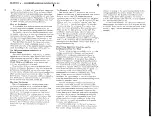
46
Remote Operation
Sending line (8) the instrument returns the current unit.
It sends back the same string as the corresponding com-
mand parameters above.
:PSKey :STAT 0|OFF|1|ON
(9)
:PSKey
:STAT?
(10)
Sending line (9) the PSK can be turned on or off. The PSK
is turned on by sending the parameters 1 or ON, and it is
turned off by sending 0 or OFF (if present).
Sending line (10) the instrument returns the current FSK
state. The instrument sends back 0, if no PSK is in pro-
gress, and 1, if PSK is present.
Example:
:PSK:SOUR EXT ; UNIT RAD ; PH0 0 ; PH1 10 ; STAT ON
6 .18 SWEEP
Commands in order to modify SWEEP parameters.
Syntax :
:FREQuency:MODE SWEep
(1)
:FREQuency :MODE FIXed | CW
(2)
:FREQuency :MODE ?
(3)
Sending line (1) the SWEEP can be turned on.
Sending line (2) the SWEEP can be turned off, if SWEEP is
present.
Sending line (3) the instrument returns the current SWEEP
state. It sends back SWE, if SWEEP is in progress, and
FIX, if no SWEEP is present.
:FREQuency:STARt
<
NUM
>
(4)
:FREQuency:STARt?
(5)
:FREQuency:STOP
<
NUM
>
(6)
:FREQuency:STOP?
(7)
Sending line (4) and (6) the two frequencies START and
STOP can be changed. The
<
NUM
>
parameter is a NR1 or
NR2 or NR3 number (see paragraph Syntax conventions).
No unit must follow the number, Hz unit is the default one.
The value is rounded to the resolution.
Sending line (5) and (7) the instrument returns the two fre-
quencies START and STOP. It sends back a string repre-
senting a NR3 decimal number.
:SWEep :TIME
<
NUM
>
(8)
:SWEep
:TIME?
(9)
Sending line (8) the SWEEP TIME can be changed. The
<
NUM
>
parameter is a NR2 number (see paragraph
Syntax conven-tions). No unit must follow the number,
sec. unit is the default one. The value is rounded to the
resolution.
Sending line (9) the instrument returns the SWEEP TIME. It
sends back a string representing a NR2 decimal number.
Example:
:SWE :TIME 5;:FREQ:STAR 16E+6;:FREQ:STOP 1.2E+9;
:FREQ :MODE SWE
6 .19 SYSTEM
Syntax:
:SYSTem:ERRor?
Sending this line the instrument returns the current error
code. This code is the first one recorded even if several er-
rors have occured. After sending the error number the in-
strument sets it to zero (it also set it to zero at power on
time). Refer to the table of the error codes.
Notes regarding the syntax
As mentioned in some examples above, in each command
line the first character ”:“ is optional. In case of successive
commands corresponding to the same tree it is not neces-
sary to repeat all the descriptions of the commands.
Example:
FM:INT:FREQ 9E+3; SHAP SIN; DEV 150E+3; STAT ON
is the same as:
:FM:INT:FREQ 9E+3; :FM:INT:SHAP SIN; :FM:DEV 150E+3;
STAT ON
In fact: FM for the first command indicates that we get into
the FM tree (group) and the following commands, if they
belong to the same group, may be shorter (without repea-
ting all the tree descriptions). If the next command does
not belong to the same tree, it is necessary to specify the
root.
6 .20 Error codes and their meaning
00 No error
01 Direct Digital Synthesis error (Hardware)
02 Internal reference error (Hardware)
03 External reference error (Hardware)
04 PLL1 error (Hardware)
05 PLL2 error (Hardware)
08 Calibration error
09 Overload error (Hardware)
15 Level error (out of range)
16 (Carrier) Frequency error (out of range)
21 AM modulation in progress (impossible to turn ano-
ther modulation on)
22 PM modulation in progress (impossible to turn ano-
ther modulation on)
23 FM modulation in progress (impossible to turn ano-
ther modulation on)
25 AM depth error (out of range)
Summary of Contents for HAMEG HM8135
Page 50: ...50 Flow Charts Flow Charts Function selection Step control Phi Phi Phi ...
Page 51: ...51 Flow Charts Amplitude Modulation Control FSK PSK GATE ...
Page 52: ...52 Flow Charts Phase Modulation Control FSK PSK GATE ...
Page 53: ...53 Flow Charts Frequency Modulation Control FSK PSK GATE ...











































